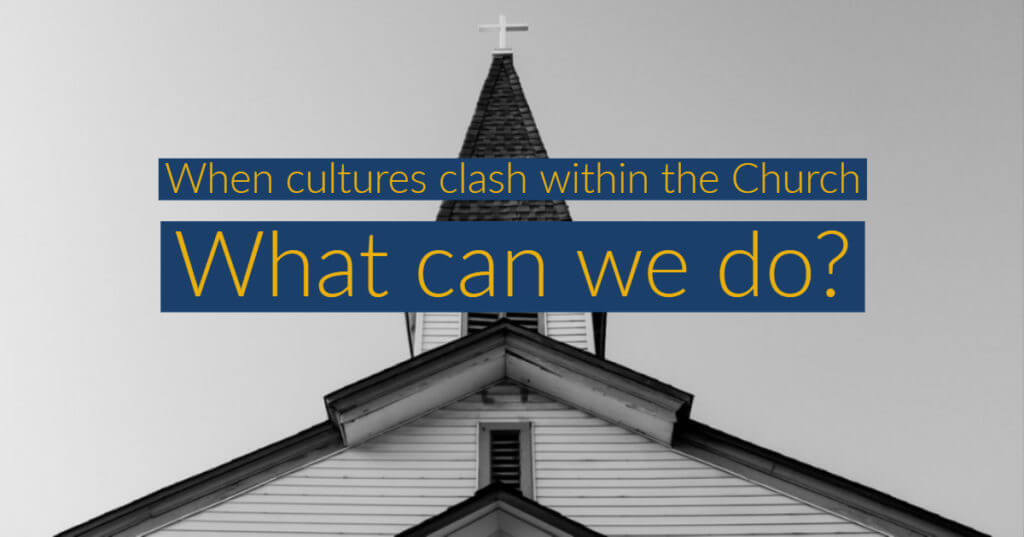I’ve concluded, for better or worse, that God has called me to help address this very challenge within the Church. God’s call to me comes partly out of my own experience as a lifelong follower of Jesus, church-goer, and PK (Pastors Kid) who has seen the negative impact of such culture clashes on the mission of the church. Part of it comes from my own leadership failures in addressing such conflict, even unintentionally exacerbating the conflict by misdiagnosis and insensitivity.
So, I come to this topic with humility and a desire to see the fulfillment of Christ’s Great Commission to make disciples of all nations, despite, and even through, the clash of cultures within the Church. I have no confidence in the flesh—I have every confidence in Jesus Christ and the power of the Holy Spirit!
Merriam-Webster defines “culture” as: “The customary beliefs, social forms, and material traits of a racial, religious, or social group, the set of shared attitudes, values, goals, and practices that characterizes an institution or organization,” and “the set of values, conventions, or social practices associated with a particular field, activity, or societal characteristic,” among the principal definitions. I find this definition helpful as I observe the “shared attitudes, values, norms and forms, goals and practices” that we see within different groups and societies at every level within the Church.
For instance, the most obvious cultures within the local church are generational. Think of the differences of values and attitudes between grandparents, parents, and children—between the Great generation, Boomers, and Millennials! Robert Logan took this a step further in the “Berry Bucket Theory of Church leadership” where he describes four different cultures invariably present within any local congregation facing change. There are the “older berries,” the stakeholders and senior members of the church who have been there long before the new pastor and the new vision arrived. Then there are the “new berries,” those who have arrived since the new pastor or vision have arrived and whom are attracted to both. Then there are the “junior older berries,” those who are younger than the pastor but part of the senior stakeholder culture, and then the “junior new berries,” those who are part of the newer stakeholders but younger than the pastor. Logan points out that culture clash and conflict becomes acute when the “new berries” increase in number and begin to assume increasing leadership and influence within the church that upsets the “older berries.” He maintains, and I concur, that the pastor has to adapt his or her leadership style to address each of those “cultures” in a way that will help them adapt to and gracefully navigate those changes. These are precisely the skills that we teach in our AAC Clergy Leadership Training Institutes and our REVIVE! Church revitalization workshops.
Within a docese, one can often find cultures clashing in conflicts between congregations and the bishop. Sometimes this is around a conflict between a congregation whose culture is more congregational and the more hierarchical culture of the diocese and its bishop. Sometimes the cultural clash is in the reverse, and often times the clergy find themselves caught in the middle. Sometimes the conflict escalates to the point of a possible conflict between bishops and dioceses around a congregation’s request to transfer. At other times, the culture clashes between diocese and bishops are around the differences between the values and norms of affinity dioceses and those of a geographical diocese, especially with respect to new church planting efforts. Frequently, the cultural values of those who hold them make them deaf to the values of others contributing to the breakdown of communication and joint mission. For all these reasons, the American Anglican Council has been sponsoring workshops to train diocesan mediators in principles of Biblical mediation. The purpose of this training is to equip leaders with a non-adversarial process that effects both a mission-friendly solution and reconciliation of all parties. For a taste of this training, check out Bishop Trevor Walters new book (to which I and others have contributed), The Power of Christian Mediation: Realizing Spirit Led Outcomes (2019, Anglican Liturgy Press).
But we can also find the clash of cultures in the Church at the global level of Anglicanism, for instance, in the differences of values and norms between North American, European, African, Asian and South American Anglicans and their church cultures. These differences often raise conflicting expectations in meetings, in mission, and in communication. Such differences can very often lead to misunderstanding and misplaced assumptions about the other and conflict.
God’s word provides guidance in how to address these cultural conflicts within the Church!
In Acts 6:1-7, we read about a cultural conflict in the Church between the “Grecian Jews” and the “Hebraic Jews” because the former believed “their widows were being overlooked in the daily distribution of food” (6:1). As John Stott observes, the Hellenistai (Grecian Jews) not only spoke Greek but also behaved like Greeks. They came from the diaspora and had settled in Palestine (think of all the Anglican “tribes and nations” that have settled in North America and planted indigenous churches). The Hebraioi (Hebraic Jews) were not only natives of Palestine who spoke the native language (Aramaic), they were also deeply immersed in Hebrew culture.[1]
In the end, the Apostles led the whole Church into a process that resulted in the word of God spreading, a rapid increase in the number of disciples in Jerusalem (evangelism, discipleship and church growth!), and even “a large number of priests becoming obedient to the faith” (miracles!) (6:7). This process involved at least four steps:
- Keep the focus on the MISSION
Ultimately, every mission of every church, at every level of the Church, flows from the one Great Co-Mission of Jesus Christ, to “make disciples of all nations.” (Matthew 28:16-20). This is exactly what the Apostles did in addressing the problem. They recognized God’s call on them to “give attention to prayer and the ministry of the word,” rather than administration (6:2-4). In short, they re-framed the presenting problems in terms of the question, “How can we move forward together in making disciples of Jesus Christ?”
This is exactly the priority we promote in our Leadership Institutes and REVIVE! Workshops as essential to defusing cultural conflict from the “Red-Zone” (where conflict focuses blame on persons and hardens positions) to the “Blue-Zone” where our discussions and disagreements are negotiated around a Biblical vision of mission to which we can all agree, just as the Church did here.
- Listen to EVERY voice within the Church.
“So the Twelve gathered all the disciples together…” (6:2, emphasis added). In other words, the Apostles did not impose a solution by virtue of their office and authority. Instead, as Stott observes, they invited the whole Church to come together “in order to share the problem with them.”[2] “Sharing the problem” certainly implies a two-way conversation. This is exactly the precursor to the kind of conciliar gathering and decision-making that we see later in Acts 15 and which I have written about elsewhere.
Sometimes we are tempted to write off a voice because of the behavior (or alleged misbehavior) associated with that voice. But if you think of the church at every level in terms of a “family system,” sometimes the behavior or misbehavior is simply an expression of a deeper problem or conflict that you will never uncover until you dig deeper and listen. That’s why it is important to listen to every voice when cultures clash within the church. Often this process of listening seriously, and without prejudice, begins to heal the hurts in such a way that uncovers the root problems and a consensus can be reached. It seems this was exactly the result in the Jerusalem church where all were gathered: “This proposal pleased the whole group…” (6:5).
- In humility, representatives from BOTH cultures address the conflict together
“They chose Stephen, a man full of faith and the Holy Spirit: also Philip, Procorus, Nicanor, Timon, Parmenas and Nicolas from Antioch, a convert to Judaism.” (6:5). All seven had Greek names. “They may all, therefore have been Hellenistai, deliberately chosen to satisfy the group who were complaining,” says Stott. If this were the case, this decision alone would have demonstrated a humility by the Hebraioi in relaxing their “grasp” on their own rights in keeping with the very mind of Christ himself (Phil. 2:5-11). But as others have noted, this is speculative. It seems more likely that ‘some of both classes of Jews were elected, the only fair and proper course.”[3]
Facilitating such a problem solving “team” from both cultures is one of the key skills that we seek to impart in our Leadership Institutes and REVIVE! Workshops, precisely because it is a Biblical way of breaking down the dividing walls of hostility and bringing the Church into a new unity as ONE body (see Ephesians 2:14-16) in Christ and for the sake of mission.
- PRAY
“They presented these men to the Apostles, who prayed and laid their hands on them…” (6:6)
We must recognize that there is a dimension of spiritual warfare in every conflict. As Stott observes, the culture clash in Acts 6:1-7 is one of three tactics which the devil employed to destroy the Church in Acts 4:32-6:7.[4] When facing such conflict within the church, it is easy to overestimate our own skill and efforts and to underestimate the need for and power of prayer. Jesus had to remind his own disciples that there are some situations of resistance that can only be overcome by prayer and fasting (See Mark 9:29). In this cultural clash within the Church, the Apostles did not simply appoint a committee. They prayed for them and laid hands upon them, inviting the Holy Spirit to empower them. Conflict within the Church is more often than not a place where we wrestle with dark angels. As Paul reminds us, we need to prioritize prayer “in the Spirit, on all occasions, with all kinds of prayers and requests…for all the saints.” (Eph. 6:18)
Have you enlisted the prayers of dedicated intercessors to pray for the leaders, and the teams they empower, to address the conflict of cultures within your church, your diocese, the Province, and the Global movement of Biblically faithful and confessing Anglicans?
If you haven’t, may I suggest you raise up such a team of intercessors as a new discipline in Lent for your whole church? May I suggest this prayer for Mission as a starting point, from the ACNA Text for Morning Prayer:
O God, you have made of one blood all the peoples of the earth and sent your blessed Son to preach peace to those who are far off and to those who are near: Grant that people everywhere may seek after you and find you; bring the nations into your fold; pour out your Spirit upon all flesh, and hasten the coming of your kingdom, through Jesus Christ our Lord.
The Rev. Canon Phil Ashey is President & CEO of the American Anglican Council.
[1] Stott, John R.W. The Message of Acts: The Spirit, the Church and the World (Downers Grove IL: IVP, 1990) at pp. 120-121.
[2] Ibid., at 121.
[3] Ibid., at 122.
[4] Ibid., at 124.



